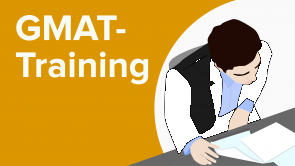(engl.) GMAT quantitative section - math review (Chapter 2, Part 1)

Über den Vortrag
Der Vortrag „(engl.) GMAT quantitative section - math review (Chapter 2, Part 1)“ von Robert Kuehl ist Bestandteil des Kurses „GMAT Preparation“. Der Vortrag ist dabei in folgende Kapitel unterteilt:
- Introduction Quantitative Section
- How to approach problems
- Process of Elimination
- Plugging-in
- Plugging-in - Example
- Plugging-in the answer choices
- Plugging-in the answer choices - Example
- Math Review
- Arithmetics
- Algebra
- Probability
- Geometry
Quiz zum Vortrag
What should you do first when working on a problem solving question on the GMAT?
- Read the question briefly and cross-off every response on your scratch paper which cannot be the solution to the question. (crazy answers)
- Calculate the task as accurately as possible and ensure a clean computation.
- Work through at least 3 different calculation methods and compare the results.
- Check for hidden clues in the text.
What is your best tool for the GMAT Quantitative section?
- Paper Based Calculation
- The GMAT calculator
- Brainstorming
- Flash Cards
When can I apply “Plugging-In” in a problem solving question?
- If all answers are variables, percentages or ratios of an unspecified amount.
- Whenever the answer has only whole numbers (integers).
- Only if the question is of relatively medium difficulty.
- If all answers include fractions.
In how many ways can you arrange 5 books in a bookcase?
- 5! = 120
- 5
- 5x5 = 25
- 5 to the power of 5 = 3125
How do I calculate the range when the standard deviation and average (arithmetic mean) are given?
- Mean - standard deviation to mean + standard deviation
- Mean + standard deviation
- Mean - standard deviation
- You need the median to calculate the range.
If the "perimeter of a right isosceles triangle" is asked, what is meant?
- The sum of the lengths of all sides of a triangle with one 90° angle and two sides of equal length
- The length of the hypotenuse in a right angle triangle
- The sum of the adjacent side of a right triangle with two sides of equal length
- The area covered by a right triangle with two sides of equal length
Diese Kurse könnten Sie interessieren
Kundenrezensionen
5,0 von 5 Sternen
| 5 Sterne |
|
1 |
| 4 Sterne |
|
0 |
| 3 Sterne |
|
0 |
| 2 Sterne |
|
0 |
| 1 Stern |
|
0 |
1 Kundenrezension ohne Beschreibung
1 Rezensionen ohne Text
Auszüge aus dem Begleitmaterial
... use common sense about the problem, then cross all answers off that are crazy. To bring the process of elimination further on you can also cross of every partial answer (which is only the first ...
... Germany are manufactured in Stuttgart. If the total number of cars produced in Germany is 5 million, how many cars are produced outside of Stuttgart? 0.78 ...
... by using common sense about the problem. If there are in total 5 million cars produced in Germany (including Stuttgart), is there any way that without counting cars from Stuttgart the total output can exceed 5 ...
... you exactly this answer choice - cross of this partial answer! Twenty-Two percent of the cars produced in Germany are manufactured in Stuttgart. If the total number of cars produced in Germany is 5 million, how many cars ...
... and with some common sense you might now be able to spot the right answer without having it calculated. (Since around 80 percent of the 5 million cars are produced outside Stuttgart Choice A with 0,78 million is ...
... which is simply the reciprocal of 22 percent. Twenty-Two percent of the cars produced in Germany are manufactured in Stuttgart. If the total number of cars produced in Germany is 5 million, how ...
... educational guessing, if the answer is so simple? Because this is an easy question just to make a point, you will see how powerful this technique is on harder questions as ...
... answer choices that are totally out of scope - Partial Answers - Second look for answers that GMAT put there to lure you ...
... to put up complex equations to solve a GMAT Math problem, often it is much easier to plug in a number. You can plug-in if, the answer choices ...
... the males are going on a tradefair to Stuttgart, then what percentage of the MBA class is going on the trade fair? (A) 82% (B) 80% ...
... concrete numbers in the answer choices it might be much easier to work backwards than to write a complex equitation. You can work backwards if: - All answer choices are numbers - The question ...
... 4 years were $30 million, what were the profits in the first year of operation? (A) $1 million (B) $2 million (C) $4 million ...
... the GMAT. Do you remember all math rules from your math classes back in High School? No? Don’t worry, you won’t need most ...
... won’t give you any points if you solved a complex math problem but failed calculating the last numbers right. Examples for Paper Based Calculation: Addition: ...
... or even rules always hold true e.g. “odd x odd=odd” or “odd + odd = even” If two numbers are distinct they have different values. The first prime numbers are 2,3,5,7,11,13 (not 0 and 1) A number is divisible ...
... The median is the number that is exactly in the middle if you arrange a set of numbers in ascending order (On even sets use the average of the two middle numbers) The ...
... of the average spread of numbers from the average. The most important rules ...
... and they are simultaneous you can add or subtract them so that one of the variables disappears. Quadratic Equations come in two forms factored e.g. (x+2)(x+5) and unfactored e.g. x²+7x+10. If you ...
... certain event: outcomes that are specified total number of possible outcomes. If a questions asks what NOT happens use the ...
... least one four? When throwing a 6-sided dice twice you have 6x6=36 possible outcomes: If the question asks for the probability of throwing a 4 at least once, there are 11 possibilities that could happen (there is only one possible way to get the 4 twice, there are five possible outcomes if the 4 comes first ...
... of choices for each of the slots, but don’t forget they are getting smaller ( like 10x9x8= 720 ) e.g. 5 teams play in a tournament, how many different rankings are possible? (5x4x3x2x1= 120 different rankings possible) Permutation if order doesn’t matter, is the same but you have to divide the result by the possibilities the slots can ...
... for GMAT Geometry (In terms of frequency): An equilateral triangle has three sides that are equal in length and all angels are 60° ...
... are x: √3x : 2x Memorize the following approximations: π = 3 , √2= 1.4 , √3=1.7 , √4=2 • There is one common right triangle: 3² + 4² = 5² ...
... Geometry (In terms of frequency): In a circle the diameter is 2 x radius and area is π x r² and the circumference is 2 π r ...
... coordinate point by dividing the difference in the y-coordinates by the difference in the x- coordinates. x1 2 3 4 5 6 7 8 9 10 11 12y 5 4 ...



